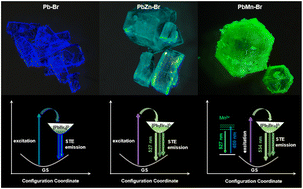Regulating the coordination geometry of polyhedra in zero-dimensional metal halides for tunable emission†
Abstract
Although self-trapped exciton (STE) emissions in zero-dimensional metal halides have been intensively investigated, the understanding of the relationship between the coordination geometries of the metal halides and their photophysical properties is still lacking. In this work, we successfully synthesized single crystals, with strong STE emissions, of the bimetallic materials (Bmpip)9[Pb3Br11](ZnBr4)2 (PbZn-Br) and (Bmpip)9[Pb3Br11](MnBr4)2 (PbMn-Br), where Bmpip+ is 1-butyl-1-methyl-piperidinium (C10H22N+), via a facile anti-solvent crystallization strategy. With respect to the monometallic material, (Bmpip)2[PbBr4] (Pb-Br), the introduction of Zn2+ and Mn2+ effectively alters the coordination geometry of the lead bromide polyhedral configuration from a PbBr42− tetrahedron to a Pb3Br115− trimer. As a result, the maximum emission peak of PbZn-Br exhibits an obvious red shift and the full width at half maximum is almost two-fold wider than that of Pb-Br due to stronger electron–phonon coupling. Moreover, due to the intrinsic emission of the Mn2+ ions, an intriguing tunable emission was achieved in PbMn-Br with an impressively high photoluminescence quantum yield of up to 67%. The ultra-stable PbMn-Br single crystals show potential as an ideal down-conversion phosphor for use in UV-pumped white light-emitting diode devices.

- This article is part of the themed collection: Halide Perovskite Optoelectronics


 Please wait while we load your content...
Please wait while we load your content...